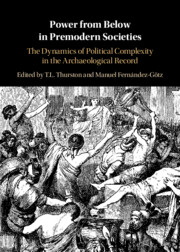 Power from Below in Premodern Societies
Power from Below in Premodern Societies Book contents
- Power from Below in Premodern Societies
- Power from Below in Premodern Societies
- Copyright page
- Contents
- Figures
- Contributors
- Preface
- One Power from Below in the Archaeological Record
- Two Fragmenting Trypillian Megasites
- Three Structure and Agency
- Four Power Requires Others
- Five “And Make Some Other Man Our King”
- Six Societies against the Chief? Re-Examining the Value of “Heterarchy” as a Concept for Studying European Iron Age Societies
- Seven Peasants, Agricultural Intensification, and Collective Action in Premodern States
- Eight The Spread of Scribal Literacy in Han China
- Nine Confronting Leviathan
- Ten The Emergence of Monte Albán
- Eleven Dispersing Power
- Twelve The Perplexing Heterarchical Complexity of New Guinea Fisher-Forager Polities at Contact
- Thirteen Restoring Disorder
- Index
- References
Two - Fragmenting Trypillian Megasites
A Bottom-Up Approach
Published online by Cambridge University Press: 08 October 2021
- Power from Below in Premodern Societies
- Power from Below in Premodern Societies
- Copyright page
- Contents
- Figures
- Contributors
- Preface
- One Power from Below in the Archaeological Record
- Two Fragmenting Trypillian Megasites
- Three Structure and Agency
- Four Power Requires Others
- Five “And Make Some Other Man Our King”
- Six Societies against the Chief? Re-Examining the Value of “Heterarchy” as a Concept for Studying European Iron Age Societies
- Seven Peasants, Agricultural Intensification, and Collective Action in Premodern States
- Eight The Spread of Scribal Literacy in Han China
- Nine Confronting Leviathan
- Ten The Emergence of Monte Albán
- Eleven Dispersing Power
- Twelve The Perplexing Heterarchical Complexity of New Guinea Fisher-Forager Polities at Contact
- Thirteen Restoring Disorder
- Index
- References
Summary
This volume is like déjà vu – here we are again trying to break away from hierarchy. In 2009, a major conference on social formations set an ambitious dual agenda: to summarize the research on that subject up to this point with a strong critique of the favored but not always justified hierarchical approach, and to offer a range of alternatives to studying and understanding human organization (Kienlin, 2012). This conference came after years of excellent scholarship on the development of contrary models (e.g. Crumley, 1987; Friedman & Rowlands, 1977) to the study and proliferation of hierarchical societies (or what are assumed to be hierarchical societies) that dominate our discipline. The contributions to this volume are part of the same cycle of the utter predominance of approaches equating power with hierarchy and centralization that are periodically challenged by the increasing number of archaeological case studies for which such approaches simply do not work.
- Type
- Chapter
- Information
- Power from Below in Premodern SocietiesThe Dynamics of Political Complexity in the Archaeological Record, pp. 40 - 60Publisher: Cambridge University PressPrint publication year: 2021


